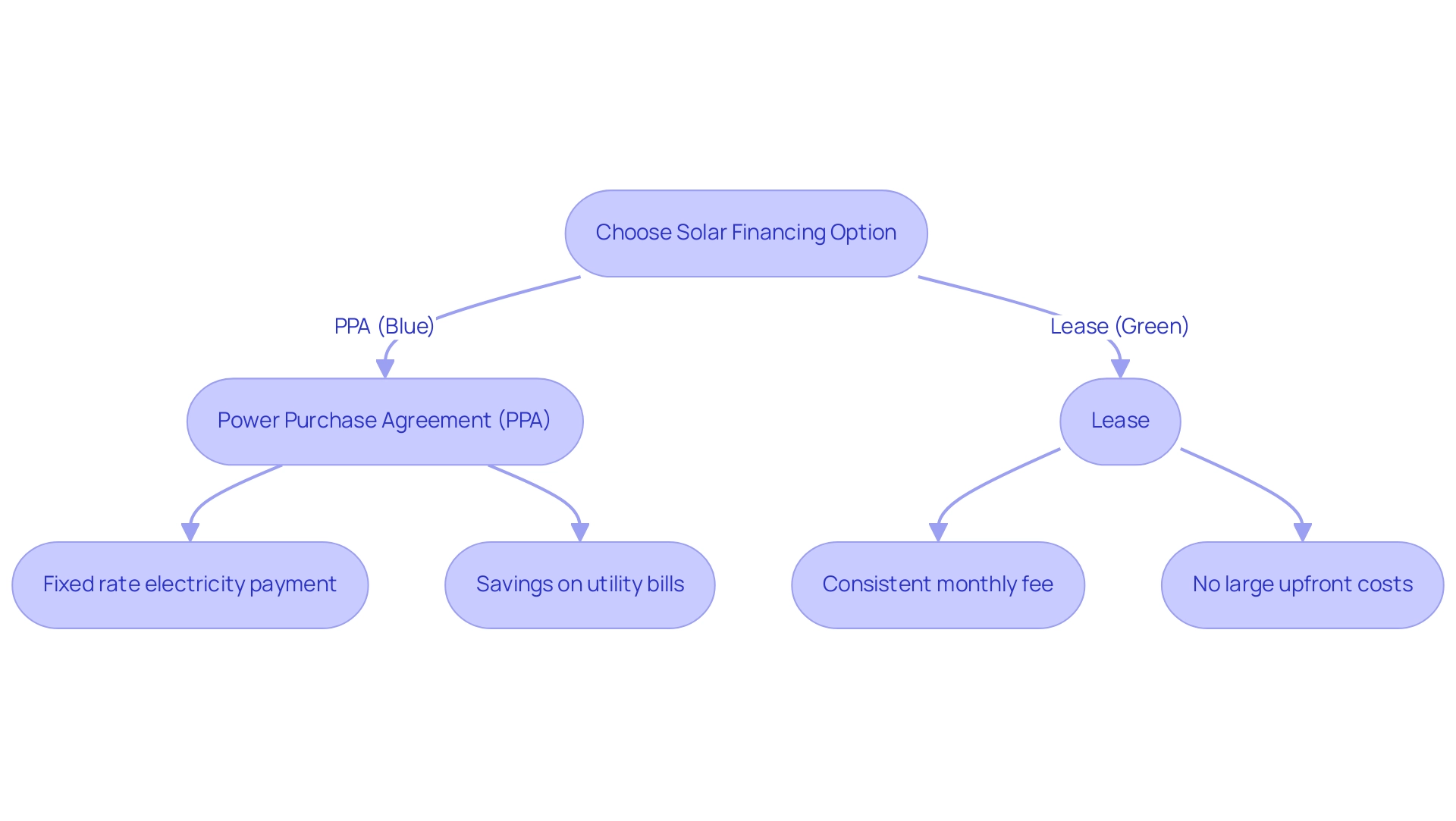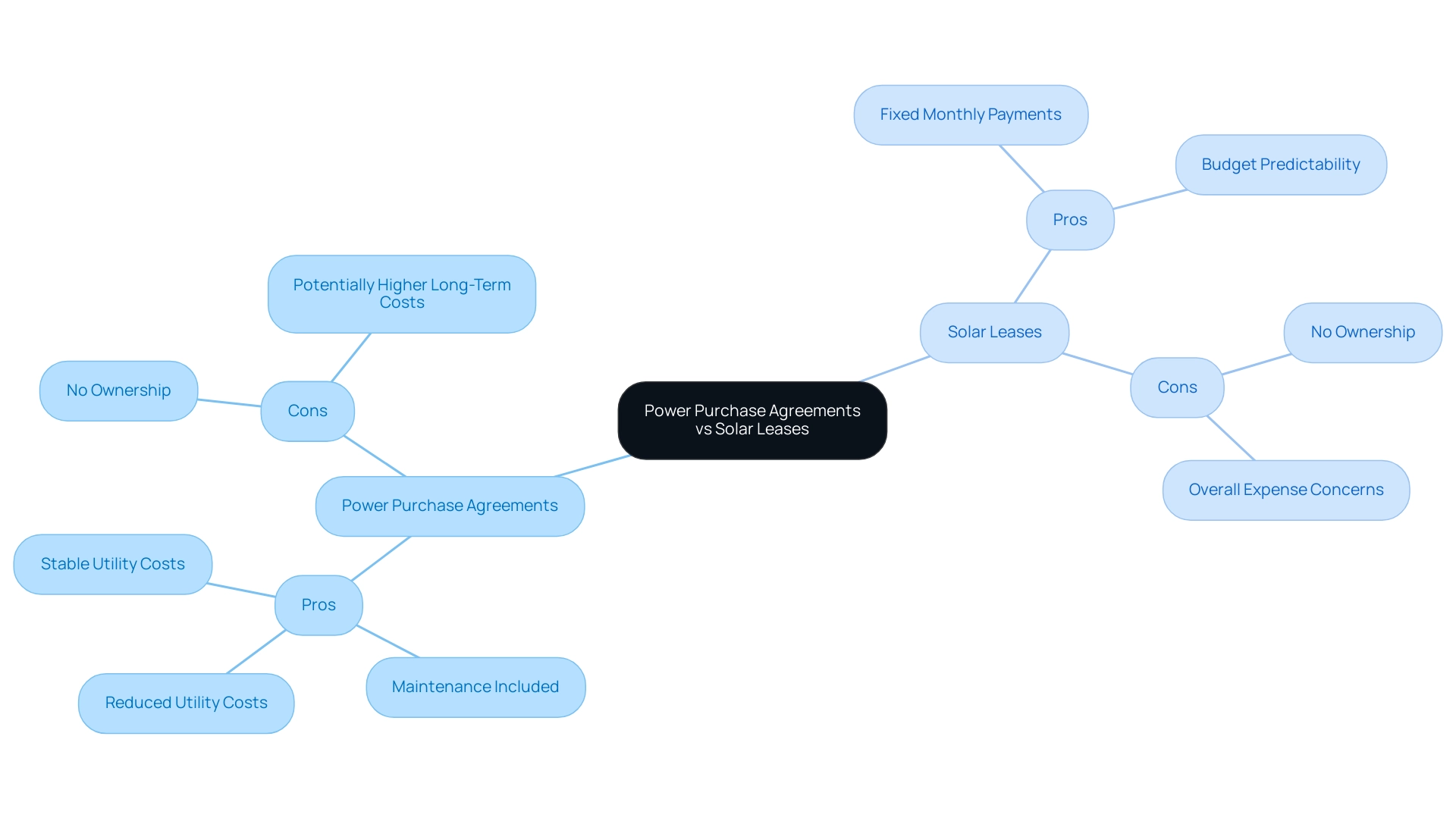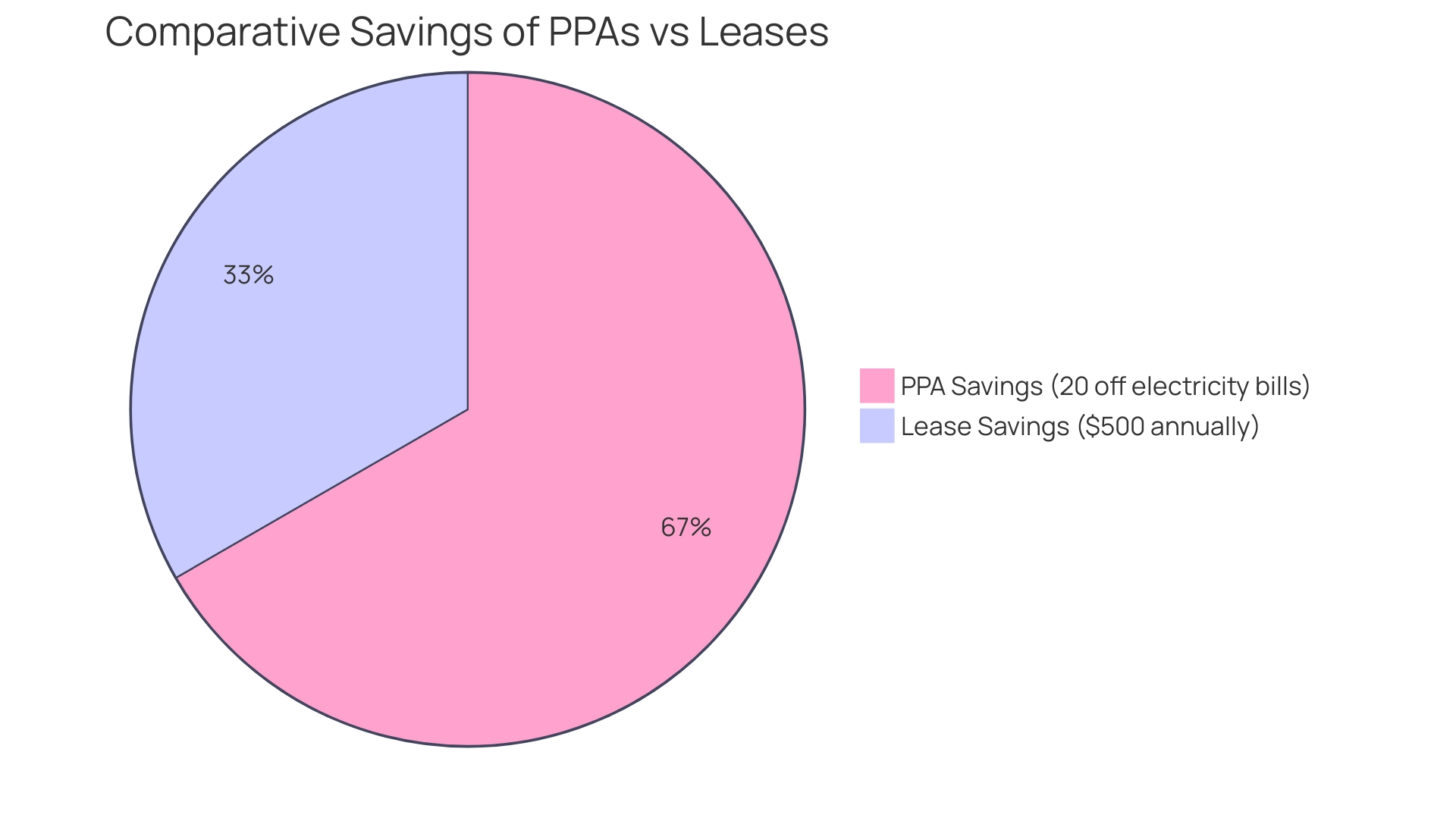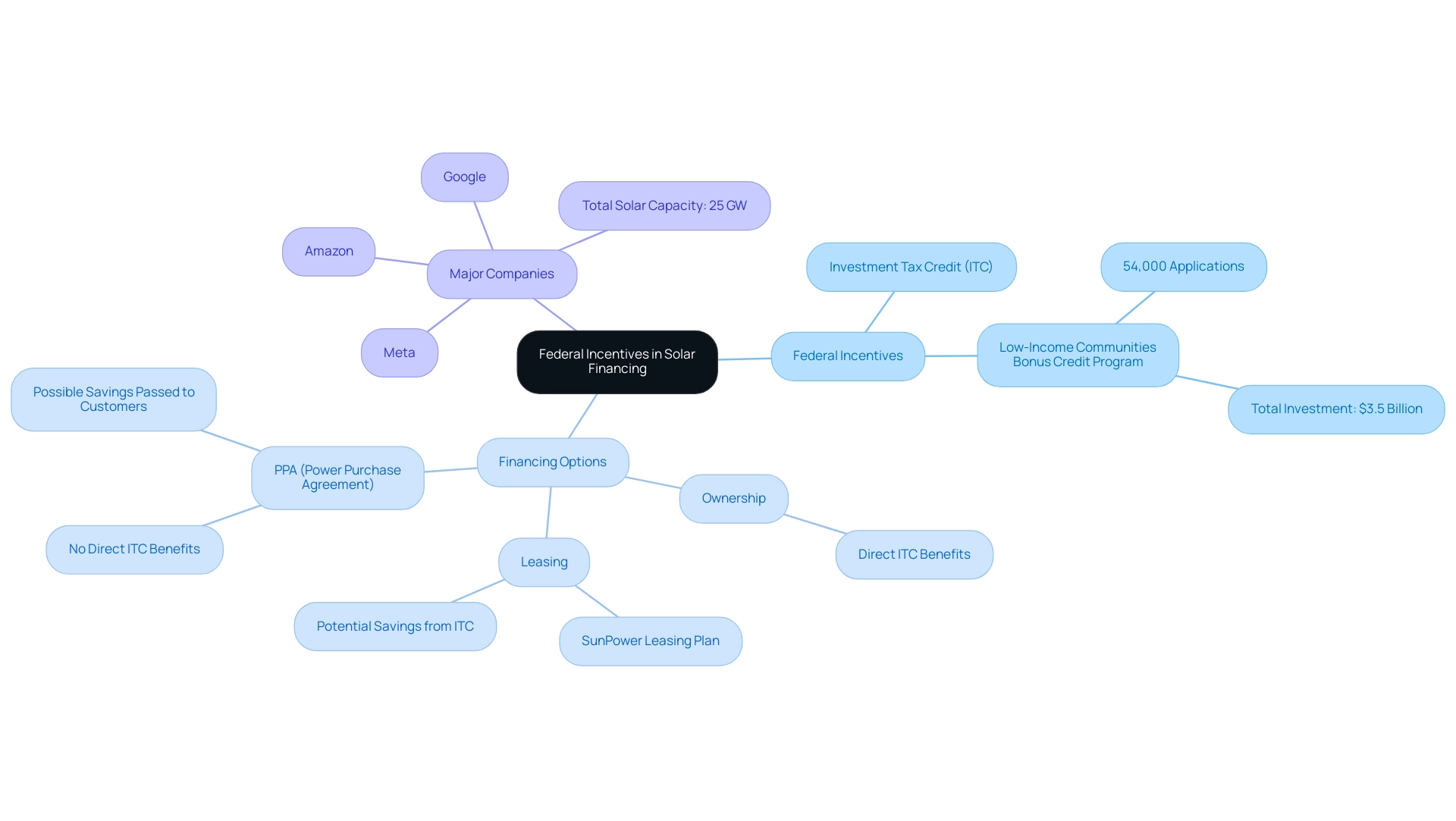Overview
The article compares two primary solar financing options: Power Purchase Agreements (PPAs) and leases, highlighting their respective benefits and drawbacks for homeowners. It explains that while PPAs can lead to lower electricity costs linked to system output, leases offer predictable monthly payments, but both options typically do not provide ownership benefits such as tax credits, making it essential for homeowners to consider their long-term financial implications and energy needs when choosing between them.
Introduction
Navigating the world of solar financing can feel overwhelming, especially with the myriad of options available to homeowners today. Power Purchase Agreements (PPAs) and solar leases stand out as popular choices, each offering unique benefits designed to make solar energy more accessible without the burden of hefty upfront costs.
As families increasingly seek sustainable energy solutions, understanding the nuances between these financing methods is essential. From potential savings on monthly utility bills to the long-term commitments involved, exploring these options can help homeowners make informed decisions that align with their eco-friendly values.
With the rising popularity of solar energy and significant federal incentives in play, now is the perfect time to dive into the details and discover which path may lead to a brighter, greener future.
Understanding Solar Financing: Power Purchase Agreements vs. Leases
When it comes to financing for renewable energy, homeowners typically have two main paths to consider: sunrun PPA vs lease. A PPA allows you to pay for the electricity produced by your energy system at a fixed rate, which is typically lower than what you’d pay your local utility. This means you can enjoy clean power while saving on your electricity bills!
On the other hand, a lease for the equipment means you’ll pay a consistent monthly fee for its use, regardless of how much electricity it generates. Both alternatives are created to make renewable energy available, removing the substantial initial expenses of acquiring a system outright. With significant savings on utility bills and the ability to heat water efficiently using sunlight, solar-powered water heaters are increasingly popular among homeowners.
These systems can heat water to temperatures as high as 400 degrees Fahrenheit, showcasing their efficiency. Recent utility-scale renewable energy prices have decreased to between $16/MWh and $35/MWh, making these funding choices even more appealing for those eager to embrace sustainability. Additionally, the expense of installing photovoltaic systems has plummeted nearly 40% over the last decade—from an average of $40,000 in 2010 to about $25,000 today—enabling more families to choose this renewable energy source for their homes.
In fact, research shows that 45 percent of renewable energy adopters in 2022 had incomes below 120% of their area’s median income, highlighting the growing accessibility of these options. According to the CFPB Office of Markets, ‘minority households collectively have a greater propensity to adopt [residential photovoltaic panels] than non-Hispanic White households,’ further illustrating the demographic trends in adoption. It’s important to note that when selecting brands, installers prioritize equipment performance and quality, brand reputation, and product warranty, which can influence financing decisions.
With renewable water heaters significantly reducing carbon emissions and enhancing property value, eco-conscious homeowners can find great long-term value in these installations. Moreover, the increasing use of water heaters in nations such as Israel and China reflects their effectiveness and acceptance, further solidifying their role in sustainable living.
Pros and Cons of Power Purchase Agreements and Solar Leases
When you’re considering the option of a Power Purchase Agreement (PPA), one of the standout benefits in the debate of sunrun ppa vs lease is the potential for reduced utility costs. With a PPA, you only pay for the electricity produced, which can lead to significant savings on your monthly bills. Many agreements also include maintenance and monitoring services, offering you that much-desired peace of mind.
However, it’s important to note that while you’re enjoying these perks, you don’t actually own the system of stars. This indicates you may forfeit important tax credits and rebates that usually come with possession, an essential factor as you evaluate your choices.
As conventional agreements can undergo price fluctuations, PPAs can offer a more stable utility cost, which is a major benefit for property owners seeking consistency in their utility expenses. On the flip side, photovoltaic leases present their own unique advantages, such as fixed monthly payments that simplify budgeting. This predictability can be a true comfort for homeowners, particularly as the renewable power market is anticipated to surpass USD 194.5 billion by 2030, emphasizing the increasing financial consequences of these agreements.
However, in the comparison of sunrun ppa vs lease, both options lack the ownership advantages, and over time, the overall expense may ultimately be greater than if you were to buy the system outright. By considering these factors, including insights into the functionality of photovoltaic panels, such as how they convert sunlight into power and the role they play in charging Tesla home chargers, along with government programs that support renewable adoption, you can better navigate the decision-making process. These programs frequently offer financial incentives that can greatly reduce installation expenses, making renewable resources more attainable.
This thorough method will assist you in selecting the alternative that best suits your power requirements and financial circumstances, ensuring you make a well-informed decision that aligns with your eco-conscious values.
Financial Considerations: Cost and Savings of PPAs vs. Leases
When assessing expenses, both the sunrun PPA vs lease for photovoltaic systems stand out as attractive choices, generally needing minimal to no initial payment. This accessibility is particularly appealing for environmentally aware residents eager to embrace solar energy. However, it’s essential to understand the long-term financial implications of the sunrun PPA vs lease options, as they can differ significantly.
For instance, research from the Solar Energy Industries Association indicates that property owners using a PPA could save an average of 20% on their electricity bills compared to traditional utility rates, especially in areas with high electricity costs. Kerry Thoubboron emphasizes, ‘With a PPA, your payment is directly linked to your system’s output, providing you confidence that you’ll gain from the power produced.’ This arrangement ensures that property owners enjoy direct savings from the energy produced.
In contrast, renewable energy leases come with fixed monthly payments, appealing to those who prefer a predictable budget. A case study in New Jersey revealed that residents choosing leases saved approximately $500 each year compared to those financing their systems through a sunrun PPA vs lease. To determine the best choice, property owners should analyze their energy consumption patterns alongside local utility rates.
By doing so, they can assess the sunrun PPA vs lease to determine which option will offer greater long-term savings, especially considering New Jersey’s strong incentives for energy-efficient property owners, including net metering and SREC programs. Comprehending how photovoltaic panels function is essential; they convert sunlight into electricity through photovoltaic cells, which can then be stored in batteries for later use. The top battery options, like the Tesla Powerwall or LG Chem RESU, improve storage efficiency and offer residents dependable power even during outages.
Moreover, consistent cleaning and upkeep of photovoltaic panels can additionally improve power generation and sustainability, guaranteeing that the system functions at optimal efficiency. By combining these components, property owners can make knowledgeable choices regarding their renewable power options.
Long-Term Commitments: Contract Lengths and Obligations
When exploring solar options like the sunrun PPA vs lease, it’s key for eco-conscious homeowners to consider that these contracts usually last between 20 to 25 years. This long-term commitment can significantly influence your future plans, especially if you’re thinking about selling your home. New buyers may need to take on the existing contract, which can introduce additional negotiation points.
For instance, when considering sunrun PPA vs lease, you might end up investing approximately $47,721 over 25 years, but with total savings of only $4,815—definitely something to consider! While these agreements can provide immediate savings on utility costs, they often come with early termination clauses that might lead to fees, adding a layer of complexity to your decision. Given that electricity rates typically rise about 3% a year, it’s wise to carefully consider these financial implications.
Additionally, exploring options like Tesla home chargers can enhance your energy efficiency and convenience. Government programs may also offer incentives that can reduce expenses and make renewable energy more accessible. To make the best choice, take the time to shop around and compare offers from various local energy installers.
Platforms like the EnergySage Solar Marketplace can assist you in discovering dependable choices that suit your needs. As Kerry Thoubboron astutely notes, ‘Instead, installers and other service providers pay us a small fee to participate after we vet them for reliability and suitability.’ This signifies you can steer your journey with assurance, aware you have evaluated choices at your fingertips.
Additionally, understanding the obligations tied to financing contracts, such as those involved in sunrun PPA vs lease, is crucial, as these commitments can impact your financial and property decisions in the long run. Incorporating battery options can further enhance your energy independence, allowing you to store excess energy for use during peak times or outages. Lastly, consider the advantages of panel cleaning services to maintain efficiency and extend the lifespan of your system.
The Role of Federal Incentives in Solar Financing Choices
Federal incentives, particularly the Investment Tax Credit (ITC), play a crucial role in making installations more affordable for homeowners. By acquiring a renewable energy system outright, you can deduct a significant percentage of the installation costs from your federal taxes, leading to substantial savings. This incentive is becoming ever more essential as clean power solutions gain greater demand—just observe the Low-Income Communities Bonus Credit Program, which attracted over 54,000 applications in its inaugural year, highlighting the strong interest in wind generation.
With a total investment of about $3.5 billion in these projects, it’s clear that there’s significant financial support for clean power initiatives. Furthermore, recent utility-scale prices for photovoltaic systems vary from $16/MWh to $35/MWh, highlighting the cost-effectiveness of this renewable source. However, if you choose between a sunrun PPA vs lease, you typically won’t benefit directly from the ITC since you don’t own the system.
Some companies may, however, pass along savings from these incentives, potentially lowering rates or fees for their customers. For example:
- SunPower presents a thorough leasing plan that enables homeowners to benefit from renewable power without the initial expenses.
- Sunrun offers adaptable financing solutions that can also utilize federal incentives to reduce total expenses.
As energy policy expert Sanya Carley notes, households with access to renewable energy can reduce their energy bills and avoid disconnections more effectively than those without.
Comprehending how these federal incentives function is crucial when assessing the true expenses of various financing methods, particularly in the debate of sunrun PPA vs lease, with updates on federal incentives for renewable energy financing expected in 2024. Moreover, major companies like Amazon, Google, and Meta have collectively contracted over 25 GW of solar capacity, showing a strong commitment to solar investments that can also benefit homeowners as they explore their options.
Conclusion
Exploring the landscape of solar financing reveals a wealth of options, with Power Purchase Agreements (PPAs) and solar leases leading the way. Each path offers unique advantages, allowing homeowners to embrace solar energy without the burden of significant upfront costs. By understanding the mechanics of these agreements, including potential savings on electricity bills and the implications of long-term commitments, families can make informed decisions that align with their financial goals and eco-friendly values.
While both PPAs and solar leases provide accessible pathways to renewable energy, they also come with considerations that require careful thought. From the potential for lower energy costs and fixed monthly payments to the absence of ownership benefits, weighing the pros and cons of each option is crucial. Homeowners should factor in their energy consumption patterns, local utility rates, and available federal incentives to determine the most beneficial choice for their circumstances.
Ultimately, the rise of solar energy presents an opportunity for families to contribute to a sustainable future while enjoying financial savings. With federal incentives and the decreasing costs of solar installations, now is the ideal time to explore these financing options. By navigating this journey with the right information and resources, homeowners can confidently select a solar solution that not only enhances their energy independence but also supports a greener planet for generations to come.







